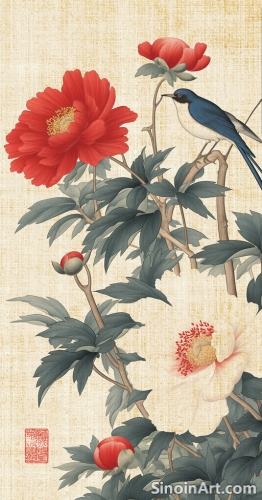Gongbi Painting and the Use of "Boneless" Technique
|
While the "gougou" method (outlining) is a defining characteristic of Gongbi painting, some artists also incorporate the "boneless" technique (没骨法, mogu fa), where forms are created using color washes alone, without preliminary outlines. This technique adds a softness and fluidity to the artwork, demonstrating the artist’s versatility and expanding the expressive possibilities of the art form. The ability to work with or without outlines shows an understanding of the broad range of techniques.  The “boneless” technique requires a high degree of control and a deep understanding of color layering. The artist must be able to use the washes of color to create forms, suggest volume, and blend seamlessly without the aid of outlines. The application of colors in layers to create the forms requires mastery of the techniques.  The application of color washes in the “boneless” technique creates a soft and fluid effect that contrasts with the precise linework that is often seen in Gongbi paintings. The blending of the colors in layers creates depth and a unique aesthetic. This technique allows for a softer and more atmospheric approach to the subject.  The use of “boneless” techniques can also help to create a sense of atmospheric perspective, blending forms and tones to suggest distance and depth. The lack of hard outlines creates an atmospheric quality that is often found in natural scenes. The incorporation of “boneless” techniques in Gongbi painting demonstrates the artist's willingness to experiment and challenge the boundaries of the traditional style. The inclusion of these techniques expands the expressive range of the art form. The artist's willingness to experiment showcases both technical skills and creative vision. The “boneless” technique adds an additional method of expression to the art form, showcasing the flexibility and versatility of Gongbi painting, and demonstrating that the traditional approaches can be blended with new ideas and techniques. The inclusion of the technique helps to broaden both the visual and expressive language of the art form. |
Tag : Boneless technique, Mogu Fa, Chinese painting techniques, color washing, Gongbi innovation
Related information
- Famous Gongbi Artists: Masters of the Meticulous Brush
- The Use of White Space in Gongbi Composition
- The Future of Gongbi: Innovation and Tradition
- Gongbi Painting in Modern Times: A Contemporary Renaissance
- The Meticulous Hand: Precision and Detail in Gongbi Painting
This article highlights the contributions of famous Gongbi artists throughout history, including Emperor Huizong, Li Tang, Qiu Ying, and Chen Hongshou, discussing their unique styles and influence on the tradition.
This article explores the importance of white space in Gongbi composition, highlighting its role in defining the main subject, creating depth, contributing to overall balance, and reflecting the philosophical principles of emptiness and the interplay of yin and yang.
A look at the future of Gongbi painting, focusing on innovation, technology, and the importance of preserving traditional skills.
This article explores the contemporary renaissance of Gongbi painting, highlighting the incorporation of modern themes, new techniques, digital technologies, and globalization in the evolution of the art form.
Chinese Gongbi painting, distinguished by its meticulous detail and precise execution, stands as a testament to the dedication and technical skill of its practitioners. Unlike the expressive spontaneity of Xieyi (freehand) painting, Gongbi emphasizes a controlled and highly detailed approach, striving for a realistic depiction of the subject matter. This pursuit of perfection is central to the aesthetic and philosophy of the Gongbi tradition.